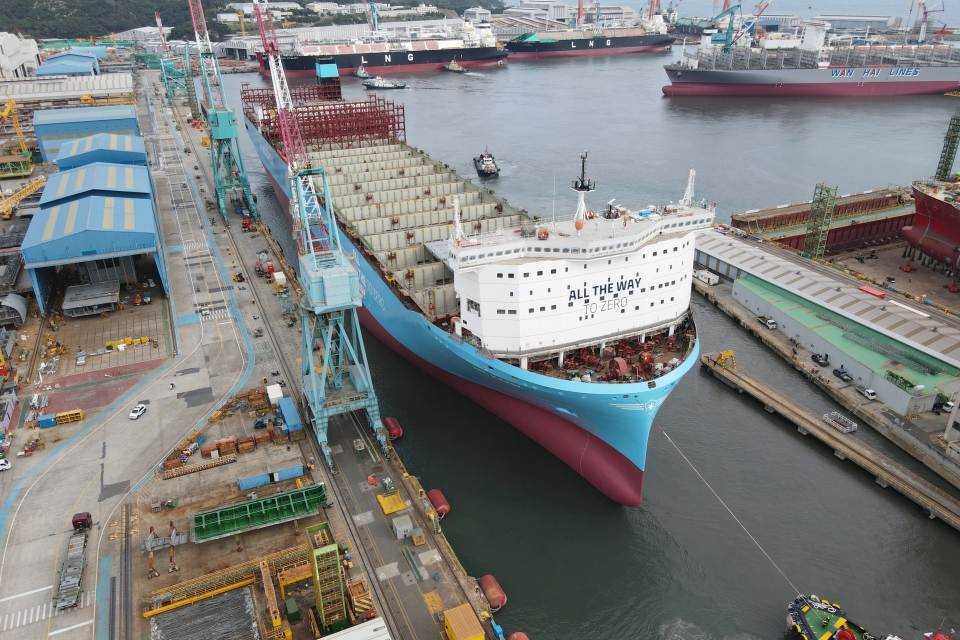Maersk’s and the world’s first large methanol-enabled container vessel has been named Ane Maersk. The ceremony took place at the shipyard of HD Hyundai Heavy Industries (HD HHI) in Ulsan, South Korea.
The vessel is named after Ane Maersk Mc-Kinney Uggla, the Chair of the A.P. Moller Foundation and A.P. Moller Holding. Ane’s eldest granddaughter served as godmother and christened the vessel by breaking a champagne bottle over the bow.
Also read: Hapag-Lloyd and Maersk forge new alliance
The first of eighteen
Ane Maersk is the first of Maersk’s eighteen large methanol-enabled vessels, that will be delivered between 2024 and 2025. It is the world’s second methanol-enabled container ship. In the beginning of February, it will enter service on the AE7 string connecting Asia and Europe.
The vessels in the new series have an industry-first innovative design with the bridge and accommodation placed at the very front of the vessel, which ensures fuel efficient operations.
‘This series of vessels will have a transformative impact on our ambition to progress on our industry-leading climate ambitions,’ says Vincent Clerc, CEO of A.P. Moller-Maersk. ‘It is a visual and operational proof of our commitment to a more sustainable industry. With Ane Mærsk and her sister vessels we are expanding our offer to the growing number of businesses aiming to reduce emissions from their supply chains.’
Ane Maersk will begin its maiden voyage on green methanol and Maersk continues to work diligently on 2024-2025 sourcing and bunkering solutions for its methanol-enabled vessel fleet.
Also read: Maersk continues to re-route around Cape of Good Hope
Ane Maersk particulars
- Flag: Danish
- Class: ABS
- Length: 350 metres
- Breadth 53.5 metres
- Speed: 21 knots
- Lightweight: 47,700 tonnes
- Deadweight: 190,000 tonnes at scantling drift of 18.0 m
- Cargo holds: 10 cargo holds, typically 29 m long, 48.5 m and 33 m high
- Container capacity: 16,592 TEU, or 2000 RFEU
- Main Engine: Hyundai-MAN B&W 8G95ME-C10.5-LGIM-EGRTC, 8 cylinders, 44,187 kW, dual-fuel type
- Auxiliary engenes: 4x HiMSEN H32DF-LM (3 x 9 cylinders each 4320 kW + 1 x 6 cylinders 2880 kW)
- Shaft generator: Wärtsilä shaft generator of 4.0 MW
- Methanol fuel capacity: 16,000 m3 in two tanks beside each other, located forward of the engine room
- Range when fully bunkered on methanol: 23,000 nautical miles
- Green fact: Running on methanol the vessel saves up to approx. 280 t of CO2 pr day compared to a sister vessel sailing on heavy fuels. When all twelve sister vessels are in operation and have replaced existing “normal” vessels, the CO2 savings will be approx. 1.5 million tonnes per year.
- Methanol fact: Consumption of methanol is approximately double that of traditional fuel due to the lower energy density.
- Planned trade lane: Ningbo, Shanghai; Nansha, Yantian (all China), Tanjung Pelepas (Malaysia), Colombo (Sri Lanka), Port Tangiers (Morocco), Felixstowe (UK), Hamburg (Germany), Antwerp (Belgium), London Gateway (UK), Le Havre (France), Port Tangiers, Jeddah (Saudi Arabia), Abu Dhabi (UAE) and Jebel Ali (UAE)
- Bunkering: The vessel will bunker in Ulsan, Korea, for the maiden voyage
Picture by A.P. Moller – Maersk. All rights reserved.
Also read: Maersk’s first large methanol ship to sail Asia-Europe route








